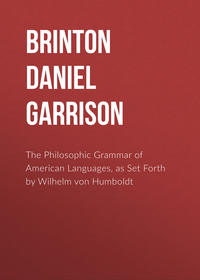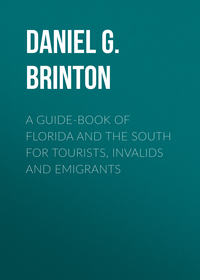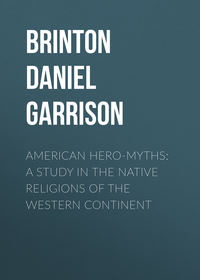 полная версия
полная версияThe American Race
The Mixtecs adjoined the Zapotecs to the west, extending along the coast of the Pacific to about the present port of Acapulco. In culture they were equal to the Zapotecs; having a preference for an agricultural life, constructing residences of brick and stone and acquainted with a form of picture or hieroglyphic writing, in which they perpetuated the memory of their elaborate mythology.173 They pretended to have taken their name from Mixtecatl, one of the seven heroes who set out from Chicomoztoc, “the land of seven caves,” far in the north, and at other times pretended descent from the fabulous Toltecs, claims which Sahagun intimates were fictions of the Nahuas living among them.174
The Zapotecs made use of a calendar, the outlines of which have been preserved. It is evidently upon the same astronomical theory as the Mexican, as was their system of enumeration. Their language is not inharmonious. It is called the ticha za, “language of the noble people.”
ZAPOTEC-MIXTEC LINGUISTIC STOCK
Amusgos, in Guerrero.
Chatinos, in Oaxaca, department of Jamiltepec.
Chuchonas, on borders of Oaxaca and Guerrero.
Cuicatecos, in Oaxaca, department of Teotilan.
Mazatecos, in Oaxaca, near boundary of Puebla, in ancient province of Mazatlan.
Mixtecos, in Oaxaca and Guerrero.
Papabucos, in Oaxaca.
Soltecos, in Oaxaca.
Zapotecos, in Oaxaca.
6. THE ZOQUES AND MIXES
The mountain regions of the isthmus of Tehuantepec and adjacent portions of the states of Chiapas and Oaxaca are the habitats of the Zoques, Mixes, and allied tribes. The early historians draw a terrible picture of their valor, savagery and cannibalism, which reads more like tales to deter the Spaniards from approaching their domains than truthful accounts.175 However this may be, they have been for hundreds of years a peaceful, ignorant, timid part of the population, homely, lazy and drunken, but not violent or dangerous. The Mixes especially cultivate abundance of maize and beans, and take an interest in improving the roads leading to their towns.176
The faint traditions of these peoples pointed to the south for their origin. When they lived in Chiapas they were conquered by the Chapanecs (Mangues), and this induced many of them to seek independence in the Sierra to the north and west. At present the main village of the Mixes is San Juan Guichicovi, while the Zoques are scattered between the Rio del Corte and the Rio Chiapa. They are described as agricultural and laborious, but also as stupid, inclined to drunkenness, and very homely.177
A comparison of the two languages leaves no doubt as to their derivation from a common stem.
ZOQUE LINGUISTIC STOCK
Chimalapas, a sub-tribe of Zoques.
Mixes, in Oaxaca, and on the Isthmus.
Tapijulapanes, on Rio de la Sierra.
Zoques, in eastern Tabasco, Chiapas and Oaxaca.
7. THE CHINANTECS
The Chinantecs inhabited Chinantla, which is a part of the state of Oaxaca, situated in the Sierra Madre, on the frontiers of the province of Vera Cruz. Their neighbors on the south were the Zapotecs and Mixes, and on the north and east the Nahuas. They lived in secluded valleys and on rough mountain sides, and their language was one of great difficulty to the missionaries on account of its harsh phonetics. Nevertheless, Father Barreda succeeded in writing a Doctrina in it, published in 1730, the only work which has ever appeared in the tongue. The late Dr. Berendt devoted considerable study to it, and expressed his conclusions in the following words: “Spoken in the midst of a diversity of languages connected more or less among themselves, it is itself unconnected with them, and is rich in peculiar features both as to its roots and its grammatical structure. It is probable that we have in it one of the original languages spoken before the advent of the Nahuas on Mexican soil, perhaps the mythical Olmecan.”178
The Chinantecs had been reduced by the Aztecs and severely oppressed by them. Hence they welcomed the Spaniards as deliverers. Their manners were savage and their disposition warlike.179 Other names by which they are mentioned are Tenez and Teutecas.
8. THE CHAPANECS AND MANGUES
In speaking of the province of Chiapas the historian Herrera informs us that it derived its name from the pueblo so-called, “whose inhabitants were the most remarkable in New Spain for their traits and inclinations.”180 They had early acquired the art of horsemanship, they were skillful in all kinds of music, excellent painters, carried on a variety of arts, and were withal very courteous to each other.
One tradition was that they had reached Chiapas from Nicaragua, and had conquered the territory they possessed from the Zoques, some of whom they had rendered tributary, while others had retired further into the Sierra. But the more authentic legend of the Chapas or Chapanecs, as they were properly called from their totemic bird the Chapa, the red macaw, recited that their whole stock moved down from a northern latitude, following the Pacific coast until they came to Soconusco, where they divided, one part entering the mountains of Chiapas, the other proceeding on to Nicaragua, where we find them under the name of Mangues, or Chorotegans, along the shores of Lake Managua.181 Here they occupied a number of populous villages, estimated by the historian Oviedo to contain about forty thousand souls.182 They were agricultural and sedentary, and moderately civilized, that is, they had hieroglyphic books, wove and spun cotton, were skilled in pottery and had fixed government. They are described as lighter in color than most Indians, and wearing long hair carefully combed. A small band wandered still further south, to the vicinity of Chiriqui Lagoon.183
The Chapanec language is one of marked individuality. Its phonetics are harmonious, but with many obscure and fluctuating sounds. In its grammatical construction we find a singular absence of distinction between subject and object. While the appreciation of number in the form of nouns is almost absent, their relations are expressed with excessive particularity, so that a noun may have different forms, as it is used in different relations.184 There is comparatively slight development of the polysynthetic structure which is generally seen in American languages.
CHAPANEC LINGUISTIC STOCK
Chapanecs, on Rio Grande in Central Chiapas.
Chorotegans, see Mangues.
Dirians, in the mountains south of Lake Managua.
Guetares, in Costa Rica.
Mangues, on Lake Managua, Nicaragua.
Orotinans, on the Gulf of Nicoya.
9. CHONTALS AND POPOLOCAS; TEQUISELATECAS AND MATAGALPAS
According to the census of 1880 there were 31,000 Indians in Mexico belonging to the Familia Chontal.185 No such family exists. The word chontalli in the Nahuatl language means simply “stranger,” and was applied by the Nahuas to any people other than their own. According to the Mexican statistics, the Chontals are found in the states of Mexico, Puebla, Oaxaca, Guerrero, Tobasco, Guatemala and Nicaragua. A similar term is popoloca, which in Nahuatl means a coarse fellow, one speaking badly, that is, broken Nahuatl. The popolocas have also been erected into an ethnic entity by some ethnographers, with as little justice as the Chontallis. They are stated to have lived in the provinces of Puebla, Oaxaca, Vera Cruz, Mechoacan, and Guatemala. Sometimes the same tribe has been called both Chontales and Popoloras, which would be quite correct in the Nahuatl tongue, since in it these words are common nouns and nearly synonymous in signification; but employed in an ethnographic sense, they have led to great confusion, and the blending into one of distinct nationalities. I shall attempt to unravel this snarl as far as the linguistic material at my command permits.
The Chontales of Oaxaca lived on the Pacific coast on the Cordillera in that State, in the Sierra Quiegolani. They were brought under instruction in the latter part of the sixteenth century by Father Diego Carranza, who labored among them for twelve years with gratifying success, and wrote a Doctrina, Sermones and Ejercicios Espirituales in their language.186 Unfortunately these works are no longer to be found, and the only specimen of their idiom which I have obtained is a vocabulary of 23 words, collected by John Porter Bliss in 1871. This is too limited to admit of positive identification; but it certainly shows several coincidences with the Yuma linguistic stock.187 Provisionally, however, I give it the name of Tequistlatecan, from the principal village of the tribe, where Father Carranza built his church. The Chontales of Guerrero were immediately adjacent to those of Oaxaca, in the same Sierra, and there is every reason to believe that they belonged to the same family; and from their location, history and associations, I do not doubt that Orozco y Berra was right in placing the Triquis in the same family.188
The Chontales of Tabasco occupied most of the basin of the Rio Grijalva. Herrera states that their language was that in general use in the province, being richer in words than the Zoque, or the provincial Mexican which has been introduced.189 This leads us to believe that it was a Maya dialect, a supposition confirmed by a MS. vocabulary obtained by the late Dr. C. H. Berendt. By this it is seen that the Chontal of Tabasco is a member of the numerous Maya family, and practically identical with the Tzendal dialect.190
In Nicaragua two entirely different peoples have been called Chontales. The first of these is also sometimes mentioned as Popolucas. Their tongue is, or a generation ago was, current in and around the city of Matagalpa and in various hamlets of the departments of Matagalpa, Segovia and Chontales. The only specimen I know of it is a vocabulary, obtained in 1874 by the Rev. Victor Noguera, and supplied by him to Dr. Berendt. It contains a small percentage of words from the neighboring dialects, but in the mass is wholly different, and I consider it an independent stock, to which I give the name Matagalpan.
The second Chontales of Nicaragua are those mentioned as Chontal-lencas by M. Désiré Pector, and are none other than the Lencas described by Mr. E. G. Squier.
The Chontal of Honduras is located geographically in those regions where the Chorti dialect of the Maya stock prevails, and there is no reasonable doubt but that it is Chorti and nothing more.
The Chontales described by Mr. E. G. Squier as living in the mountains north of Lake Nicaragua, about the sources of the Blewfield river, and of whose language he gives a short vocabulary,191 are proved by this to be members of the extensive family of the Ulvas.
Of the various tribes called Popolocas, that living at the period of the conquest in and near Puebla was the most important. Their chief city was Tecamachcalco, and they occupied most of the old province of Tepeaca. We can form some idea of their number from the statement that in the year 1540 Father Francisco de las Navas visited their country for missionary purposes, and in less than two months converted (!) and baptized 12,000 of them, and this without any knowledge of their language.192 The first who did obtain a familiarity with it was Francisco de Toral, afterwards first bishop of Yucatan. He described it as most difficult, but nevertheless succeeded in reducing it to rules and wrote an Arte y Metodo of it, now unfortunately lost.193 Its relationship has remained obscure. De Laet asserted that it was merely a corrupt dialect of the Nahuatl;194 while Herrera was informed by his authorities that it was a wholly different tongue.195 In this opinion he was right. In 1862 Dr. Berendt succeeded in obtaining a short vocabulary of it as it is still spoken at Oluta, Tesistepec, San Juan Volador and the neighboring country. A comparison shows that it belongs to the Mixe family. The ancient province of Tepeaca adjoined directly the territory of the Mixes, and this identification proves that their tongue was more important and extended much more widely than has hitherto been supposed. It was spoken, therefore, by the Tlapanecos, Coviscas and Yopes, who were located in this region.
The Popoloca of Oaxaca is an entirely different tongue. It is mentioned as identical with the Chochona, and some have supposed this dialect, in which we have a Catecismo by Father Roldan, was the same as the Popoloca of Tepeaca. This is an error. As I have said, the first missionary to master and write about the latter was Father Toral, who wrote his Arte about 1561; but more than ten years before that, to wit, in 1550, Father Benito Fernandez had printed in the city of Mexico his Doctrina en Lengua Misteca, and had composed variants in the Tepuzcolola and Chochona dialects of that tongue.196 The Chochona or Popoloca, of Oaxaca, belongs to the Zapotec-Mixtec, and not to the Zoque-Mixe family.
The Popolocas who lived in and near Michoacan were also called Tecos, and Orozco y Berra enumerates the language they spoke, the Teca, among those which are extinct.197 The name Tecos, however, was merely an abbreviated form of Cuitlatecos, and was applied to the conquered Nahuatl population around Michoacan. In some of the old glossaries teco is explained by Mexicano.198 The language they spoke belonged to the Nahuatl branch of the Uto-Aztecan stock.
The Popolocas of Guatemala were located at the close of the eighteenth century in two curacies widely apart.199 One of these was Yanantique, partido of San Miguel, province of San Salvador, and contained the villages Conchagua and Intipuca. Now Intipuca is a Lenca name, as stated by Mr. Squier, and we are thus authorized to identify these Popolocas with the Lencas. The other Popolocas were at and near Conguaco in the partido of Guazacapan, province of Escuintla, where they lived immediately adjacent to the Xincas. Dr. Otto Stoll identifies them with the Mixes, but by an error, as he mistook the vocabulary collected by Dr. Berendt of the Popoloca of Oluta, for one of the Popoloca of Conguaco.200 What language is spoken there I do not know, as I have not been able to find a word in it in any of my authorities.
Dr. Julius Scherzer has further added to the confusion about the Popolocas of Guatemala by printing at Vienna a vocabulary under this name which he had obtained near the Volcan de Agua.201 It is nothing more than the ordinary Cakchiquel dialect of that locality, known as the lengua metropolitana from its official adoption by the church.
10. THE MAYAS
The geographical relations of the members of the Maya stock are in marked contrast to those of the Uto-Aztecan—its only rival in civilization. Except the colony of the Huastecas on the shores of the Gulf of Mexico in the valley of the Rio Panuco, all its dialects were in contiguity. The true Maya, which is believed to be the purest form of the language, extended over the whole of the peninsula of Yucatan, around Lake Peten, and far up the affluents of the Usumacinta, the dialect of the Lacandons being closely akin to it. The principal tribes in Guatemala were the Quiches, the Cakchiquels and the Mams; while in Tabasco the Tzendals and the Tzotzils held an extensive territory. We cannot identify the builders of the ruined cities of Palenque in Tabasco and Copan in Honduras with the ancestors of any known tribe, but the archæological evidence is conclusive that whoever they were, they belonged to this stock, and spoke one of its dialects.
The historic legends of several members of the family have been well preserved. According to the earliest authorities, those of the Quiches went back more than eight hundred years before the conquest,202 that is, to about 700 A. D.; while the chronicles of the Mayas seem to present a meagre sketch of the nation nearly to the beginning of the Christian era.203 The uniform assertion of these legends is that the ancestors of the stock came from a more northern latitude, following down the shore of the Gulf of Mexico. This is also supported by the position of the Huastecas, who may be regarded as one of their tribes left behind in the general migration, and by the tradition of the Nahuas which assigned them a northern origin.204 So far no relationship has been detected with any northern stock, but the striking similarity of some art remains in the middle Mississippi to those of Yucatan, suggests that one should search in this vicinity for their priscan home.205
Physically the Mayas are short, strong, dark, and brachycephalic. The custom of compressing the skull antero-posteriorly which formerly prevailed, exaggerated this latter peculiarity. When first encountered by the Spaniards they were split into a number of independent states of which eighteen are enumerated in Yucatan alone. According to tradition, these were the fragments of a powerful confederacy which had broken up about a century before, the capital of which was Mayapan. The tribes were divided into gentes, usually named after animals, with descent in the male line. A man bore the names of both his father’s and mother’s gens, but the former was distinguished as his “true name.” The chieftainship was hereditary, a council from the gentes deliberating with the ruler.
The art in which these people excelled was that of architecture. They were born builders from a remote epoch. At the time of the conquest the stately structures of Copan, Palenque, T’Ho, and many other cities were deserted and covered with an apparently primitive forest; but others not inferior to them Uxmal, Chichen Itza, Peten, etc., were the centers of dense population, proving that the builders of both were identical. The material was usually a hard limestone, which was polished and carved, and imbedded in a firm mortar. Such was also the character of the edifices of the Quiches and Cakchiquels of Guatemala. In view of the fact that none of these masons knew the plumb-line or the square, the accuracy of the adjustments is remarkable.206 Their efforts at sculpture were equally bold. They did not hesitate to attempt statues in the round of life-size and larger, and the facades of the edifices were covered with extensive and intricate designs cut in high relief upon the stones. All this was accomplished without the use of metal tools, as they did not have even the bronze chisels familiar to the Aztecs. Gold, silver and copper were confined to ornaments, bells and similar purposes.
The chief source of the food supply was agriculture. Maize was the principal crop, and the arable land was carefully let out to families by the heads of the villages. Beans and peppers were also cultivated and bees were domesticated, from which both honey and wax, used in various arts, were collected. Cotton was woven into fabrics of such delicacy that the Spaniards at first thought the stuffs were of silk. It was dyed of many colors, and was the main material of clothing. Brilliant feathers were highly prized. Their canoes were seaworthy, and though there was no settlement of the Mayas on the island of Cuba as has been alleged, there was a commercial interchange of products with it, since Columbus was shown wax from Yucatan and was told about the peninsula. An active commerce was also maintained with southern Mexico, along the Gulf Coast, the media of exchange being cacao beans, shells, precious stones and flat pieces of copper.207
The points which have attracted the most attention in Maya civilization, next to its architecture, are the calendar and the hieroglyphics. The calendar is evidently upon the same basis as that of the Mexicans, turning upon the numerals thirteen, twenty, and four. But the Mayas appear to have had more extended measures for the computation of time than the Aztecs. Besides the cycle of twenty years, called by them the katun, and that of fifty-two years, they had the ahau katun, or Great Cycle, of two hundred and sixty years.
Both the Cakchiquels, Quiches and Mayas of Yucatan were literary peoples. They made frequent use of tablets, wrote many books, and covered the walls of their buildings with hieroglyphs carved on the stone or wood, or painted upon the plaster. Their characters are entirely different from those of the Mexicans. Most of them have rounded outlines, something like that of a section of a pebble, and for this reason the name “calculiform” has been applied to the writing. Their books were of maguey paper or of parchment, folded like those of the Mexicans. Although five or six of them have been preserved, as well as numerous inscriptions on the walls of buildings, no satisfactory interpretations have been offered, largely, perhaps, because none of the interpreters have made themselves familiar with the Maya language.208
Imperfect description of the myths and rites of the Yucatecan Mayas are preserved in the old Spanish authors; while of the Quiches we have in the original their sacred book, the Popol Vuh with a fair translation by the Abbé Brasseur de Bourbourg.209 This may well be considered one of the most valuable monuments of ancient American literature, and its substantial authenticity cannot be doubted. Its first part presents a body of ancient mythology and its second the early history of the tribe. The latter is supplemented by a similar document relating to the history of their neighbors the Cakchiquels, written at the time of the conquest, which I have published from the unique MS. in my possession.210 Many facts relating to their ancient mythology, history and superstitions were written down by educated natives of Yucatan in a series of documents entitled “the Books of Chilan Balam,” copies of a number of which have been preserved.211 They are replete with curious material.
MAYA LINGUISTIC STOCK
Achis, in eastern Guatemala, now extinct.
Aguatecas, in Aguacatan, Guatemala.
Cakchiquels, in central Guatemala.
Chaneabals, in eastern Chiapas.
Chinantecos or Cinantecos, same as Tzotzils.
Choles, in Depart. Palenque, in Chiapas.
Chortis, in valley of Rio Montagua, near Copan.
Huastecas, on Rio Panuco, north of Vera Cruz.
Ixils, on head-waters of Rio-Salinas, in Guatemala.
Lacandons, on the Rio Lacandon.
Mams, in western Guatemala.
Mayas, in peninsula of Yucatan.
Mopans, north of the Chols, in Guatemala.
Quekchis, on Rio Cahabon, in Guatemala.
Quiches (Utlateca), head-waters of Rio Grande, Guatemala.
Pokomams, south of Rio Grande, in Guatemala.
Pokonchis, in central Guatemala.
Tzendals, in Tabasco and Chiapas.
Tzotzils, in Chiapas.
Tzutuhils, south of lake Atitlan, Guatemala.
Uspantecas, on Rio Negro, Guatemala.
11. THE HUAVES, SUBTIABAS, LENCAS, XINCAS, XICAQUES, “CARIBS,” MUSQUITOS, ULVAS, RAMAS, PAYAS, GUATUSOS
The small tribe of the Huaves occupies four hamlets on the isthmus of Tehuantepec on the Pacific Ocean.212 The men are tall and strong but the women are unusually ugly. Their occupation is chiefly fishing and they have the reputation of being dull. The language they speak is said to be of an independent stock, and according to various writers the tribe claims to have come from some part of the coast a considerable distance to the south. The vocabularies of their tongue are too imperfect to permit its identification.
The Subtiabas are inhabitants of the valley of that name near the modern city of Leon in Nicaragua. They were called Nagrandans by Mr. E. G. Squier,213 because the site of ancient Leon was on the plain of Nagrando and the province also bore this name at the time of the conquest. They are probably the descendants of the ancient Maribois, whom both Oviedo and Palacios place a few leagues from Leon and to whom they ascribe an independent language; but it is an error of some later writers to confound them with the Chorotegans or Mangues, to whom they had no relationship whatever. Their language stands by itself among the inter-isthmian stocks.











